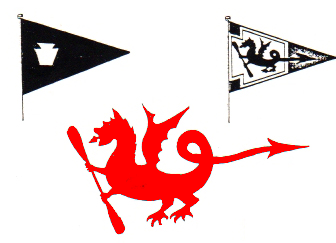The author of this is unknown, but I strongly suspect it was written by Judge Murray sometime between 1916, which is the last date mentioned, and 1923 when the club took possession of the Shipman Property.
The Red Dragon Canoe Club
A Short History

The Red Dragon Canoe Club is one of probably not over a dozen canoe clubs founded prior to 1890 that has been in continuous existence ever since. Sandford Northup, D. Morton Bond and Harry M. Kreamer started the Red Dragon Canoe Club early in 1886. Northup designed the flag, an adaption partly from the Jabberwock and partly from the golden dragon flag, of the then Chinese Empire, with the paddle added as symbolic of the Club's interests. The dragon was made red so that he would show better against the white burgee, and not for the reason given in the famous old Dragon hymn.
Late in 1888 the Club, then numbered about a dozen members, received a proposal from the Keystone Canoe Club to combine with them. and at a joint meeting held on January 4. 1889, and presided over by W. T. Norgrave, Vice-Commodore of the Keystone Canoe Club, the formal union took place, the combined Club retaining the name of the Red Dragon. The flags were likewise combined, a blue keystone on a white burgee. with the red dragon, appearing in the A.C. A. year book for 1890.The keystone was abandoned in 1893 and from then on the flag has remained as it now is.
The first officers of the Club. after the union with the Keystone. were Commodore C. B. Haag, Vice-Commodore H. M. Kreamer. Purser F. W. Noyes, Captain W. T. Norgrave.
ire in the latter part of 1890, and it was a club sadly diminished in numbers but not in enthusiasm that emigrated to Bridesburg on the upper part of the Philadelphia waterfront in 1891. Very much better quarterswere secured in 1892, when the Club moved to its present location at Wissinoming on the Delaware River, the property originally known as Magnolia Grove built in 1779. This house contains fifteen rooms. and the property consists of about two and one-half acres. Members of the Club have erected thirteen cabins on the Club grounds during their occupancy of the place.
The Club was incorporated December 21. 1895. its affairs. financial and other, have always been conservatively managed. and the membership has always been limited. The Club's present prosperous condition, with no debt and a very considerable sinking fund, laid aside and invested against theinevitable time when it will be necessary to move further up the river and to buy its own home testify tothe efficient administration of its trustees, most of whom have been elected and re-elected term after term with no changes except those caused by infrequent resignations.
The Red Dragons have been interested in A.C. A. affairs almost from the beginning of the Club. The writer's file of A.C.A. year books goes back as far as 1891. In that book the names of thirteen Red Dragons appear. Members of the Club nave been Vice-Commodores. division pursers. and members ofthe A. C. A. Executive Committee with considerable frequency. Several Red Dragons cruised to the Peconic Bay Meet in 1890. There were about a dozen at the Croton Point Meet in 1894, and the Club was almost continuously represented at: A. C. A. meets up to about 1902, and at intervals since.
Several meets, both of the Atlantic and Delaware-Chesapeake Divisions have been held on its grounds or under its auspices.
The Maclister Memorial Paddling Trophy was presented by the Club to the Atlantic Division in 1905 inmemory of its Commodore John C. Maclister who died on January 3rd of that year. The Red Dragon Paddling Trophy was presented to the Delaware-Chesapeake Division shortly after the organizationof that division in 1916.
The present officers of the Club are Commodore W. B. Masland; Vice Commodore H. B. Fort; Purser E. R. Coleman; Quartermaster R. A. Johnston; Correspondent C. Bowyer Vaux; Fleet Surgeon Dr. F. 0. Gross; Measurer M. D. Wilt; Trustees H. E. Fleschmann. Clayton Wilson and J. A. Edger.
Lack of space forbids any further account of this old A. C, A. Club, but the writer ventures two predictions — there will always be Red Dragons on the A.C. A. membership list, and the well-known hospitality of the Dragons will never be less well known to the A.C. A.